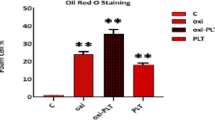Abstract
Atherosclerosis is a chronic disease that causes various cardiovascular complications. It has been realized that cellular and humoral immunity plays crucial roles in atherogenic lesion formation. In this study the effects of lipopolysaccharide (LPS) and interleukin-10 (IL-10) on the formation of foam cells during the early stages of atherosclerosis have been investigated. Macrophage was induced by phorbol myristate acetate (PMA) treatment on THP-1 cells. The cells were further stimulated by ox-LDL, ox-LDL plus LPS, ox-LDL plus IL-10 and LPS. By using an oil red O staining technique, the formation of foam cells was evaluated by lipid granules formation in the cells. The ratio of foam cell formation was increased from (9.77 ± 1.70)% to (16.27 ± 2.27)% after 24 h stimulation with ox-LDL, and the increase was observed with incubating time. The foam cells were significantly increased in the presence of LPS in a dose-dependent manner. The maximum increase of about 40% was observed. However, the significant elevation by LPS was abrogated when IL-10 was added. These results indicated that IL-10 can effectively prevent the formation of foam cells induced by ox-LDL with or without LPS. This study demonstrates that ox-LDL can cause foam cell formation from macrophages in vitro. LPS can significantly accelerate this event. IL-10, an anti-inflammatory cytokine, can inhibit the effect of ox-LDL and LPS. These results indicate that inflammatory effects in blood vessels can speed up foam cell formation. The inhibitive effect of IL-10 is an important factor for delaying atherosclerosis processes.
Similar content being viewed by others
References
Glass C K, Witztum J L. Atherosclerosis. the road ahead. Cell, 2001, 104(4): 503–516
Hansson G K. Immune mechanisms in atherosclerosis. Arterioscler Thromb Vasc Biol, 2001, 21(12): 1876–1890
Frostegard J. Autoimmunity, oxidized LDL and cardiovascular disease. Autoimmun Rev, 2002, 1(4): 223–237
Fichtlscherer S, Breuer S, Heeschen C, Dimmeler S, Zeiher A M. Interleukin-10 serum Levels and systemic Endothelial vasoreactivity in patients with coronary artery disease. J Am Coll Cardiol, 2004, 44(1): 44–49
Anguera I, Miranda-Guardiola F, Bosch X, Filella X, Sitges M, Marín J L, Betriu A, Sanz G. Elevation of serum levels of the anti-inflammatory cytokine interleukin-10 and decreased risk of coronary events in patients with unstable angina. Am Heart J, 2002, 144(5): 811–817
Heesche C, Dimmeler S, Hamm C W, Fichtlscherer S, Boersma E, Simoons M, Zeiher A. Serum level of the anti-inflammatory cytokine interleukin-10 is an important prognostic determinant in patients with acute coronary syndromes. Circulation, 2003, 107(16): 2109–2114
Von Der Thusen J H, Kuiper J, Fekkes M L, Vos P D, Van Berkel T J C and Biessen E A L. Attenuation of atherogenesis by systemic and local adenovirus-mediated gene transfer of interleukin-10 in LDLr-/-mice. FASEB J, 2001, 15(14): 2730–3732
Pinderski L J, Fischbein M P, Subbanagounder G, Fishbein M C, Kubo N, Cheroutre H, Curtiss L K, Berliner J A, Boisvert W A. Overexpression of interleukin-10 by activated T lymphocytes inhibits atherosclerosis in LDL receptor-deficient mice by altering lymphocyte and macrophage phenotypes. Circ Res, 2002, 90(10): 1064–1071
Rubic T, Lorenz R L. Downregulated CD36 and ox-LDL uptake and stimulated ABCA1/G1 and cholesterol efflux as anti-atherosclerotic mechanisms of interleukin-10. Cardiovasc Res, 2006, 69(2): 527–535
Zerbinatti C, Gore R W. Uptake of modified low-density lipoproteins alters actin distribution and locomotor forces in macrophages. Am J Physiol Cell Physiol, 2003, 284(2): 555–561
Murphy J E, Tedbury P R, Homer-Vanniasinkam S, Warlker J, Ponnambalam S. Biochemistry and cell biology of mammalian scavenger receptors. Atherosclerosis, 2005, 182(1): 1–15
Ohashi R, Mu H, Yao Q, Chen C. Atherosclerosis: immunopathogenesis and immunotherapy. Med Sci Monit, 2004, 10(11): RA255–RA260
Greaves D, Gordon S. Recent insights into the biology of macrophage scavenger receptors. J lipid Res, 2005, 46(1): 11–20
Lucas A D, Greaves D R. Atherosclerosis: role of chemokines and macrophages. Expert Rev Mol Med, 2001, 3(25): 1–18
Mostafa Mtairag E, Chollet-Martin S, Oudghiri M, Laquay N, Jacob M P, Michel J B, Feldman L J. Effects of interleukin-10 on monocyte/endothelial cell adhesion and MMP-9/TIMP-1 secretion. Cardiovas Res, 2001, 49(4): 882–890
Potteaux S, Esposito B, van Oostrom O, Brun V, Ardouin P, Groux H, Tedgui A, Mallat Z. Leukocyte-Derived Interleukin 10 Is Required for Protection Against Atherosclerosis in Low-Density Lipoprotein Receptor Knockout Mice. Arterioscler Thromb Vasc Biol, 2004, 24(8): 1474–1478
Raychaudhuri B, Fisher C J, Farver C F, Malur A, Drazba J, Kavuru M S, Thomassen M J. Interleukin 10 (IL-10)-mediated inhibition of inflammatory cytokine production by human alveolar macrophages. Cytokine, 2000, 12(9): 1348–1355
Shanley T P, Vasi N, Denenberg A. Regulation of chemokine expression by IL-10 in lung inflammation. Cytokine, 2000, 12(7): 1054–1064
Amico G D, Frascaroli G, Bianchi G, Transidico P, Doni A, Vecchi A, Sozzani S, Allavena P, Mantovani A. Uncoupling of inflammatory chemokine receptors by IL-10: generation of functional decoys. Nature Immunology, 2000, 1(5): 387–391
Peiser L, Winther M, Makepeace K, Hollinshead M, Coull P, Plested J, Kodama T, Moxon E, Gordon S. The class A macrophage scavenger receptor is a major pattern recognition receptor for nesseria meningititdis which is independent of lipopolysaccharide and not required for secretory responses. Infect Immun, 2002, 70(10): 5346–5354
van Berkel T, Out R, Hoekstra M, Kuiper J, Biessen E, van Eck M. Scavenger receptors: friend or foe in atherosclerosis. Curr Opin Lipidol, 2005, 16(5): 525–535
Mallat Z, Besnard S, Duriez M, Deeluze V, Emmanuel F Bureau MF, Soubrier F, Esposito B, Duez H, Fievet C, Staels B, Duverger N, Scherman D, Tedgui A. Protective role of IL-10 in atherosclerosis. Circ Res, 1999, 85(8): e 17–24
Author information
Authors and Affiliations
Corresponding author
Additional information
__________
Translated from Journal of Tongji University (Medical Science), 2007, 28(1): 1–5 [译自: 同济大学学报(医学版)]
Rights and permissions
About this article
Cite this article
Wang, F., Dai, Y., Xu, T. et al. Effect of IL-10 on formation of foam cell induced by ox-LDL. Front. Med. China 2, 298–302 (2008). https://doi.org/10.1007/s11684-008-0057-3
Published:
Issue Date:
DOI: https://doi.org/10.1007/s11684-008-0057-3




